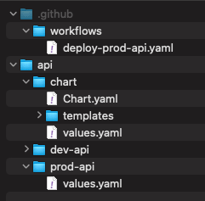You know how sometimes you create an Action just so every dev on earth doesn’t have to create their own automation? That’s how we wound up creating Deploy Helm to EKS.
Instead of manually deploying Helm to EKS, you can use this Action to automate deployment from your GitHub workflow.
We’ve tried it out with our clients to automate the deployment of Helm charts, and we think it’s ready to share with you.
Why Use Helm Charts
When you’re deploying an application to a Kubernetes cluster, you need several specific YAML files: deployment, service, ingress, config maps, service accounts, secrets, and so on. You then customize those files for each cluster/environment/namespace.
Helm allows you to create templates from those YAML files, replacing actual values with a variable.
These variables have their default values defined in a file called values.yaml. Once that file’s in place, we can then create custom values.yaml files for each deployment, or just pass in key/value pairs.
In short, Helm is a great tool that allows you to have a single chart for all deployments while still being able to have customizations for different environments.
Why Use the Deploy Helm to EKS Action
The Deploy Helm to EKS action automates the steps needed to connect to EKS and deploy a Helm Chart. The action creates the Namespace if it doesn’t exist and then performs the installation of the Helm Chart. As an added bonus, it works for fresh installations as well as updates.
This action also simplifies a couple of things. It removes the need to obtain and store a config file for each cluster, since we’re using AWS credentials to connect to the EKS cluster by name. It also makes it easier to determine how all of our different values and files that we need to pass are used, since the action makes them all inputs.
How to Use the Deploy Helm to EKS Action
To demonstrate how the action works, I’ll walk you through an example. 
In our example, we’ll assume a directory structure such as the one on the right. It includes a folder called API (our microservice) with a folder for the Helm chart files.
We also have a folder inside API for each namespace. In our example, the namespace and the cluster name are environmental variables.
Prepare
To prepare, create 2 GitHub secrets, which I’ll recommend calling AWS_ACCESS_KEY_ID and AWS_SECRET_ACCESS_KEY. These secrets should contain the Secret-Access-Key and the Access-Key-ID of an AWS account that has rights to deploy to the EKS cluster(s).
Your EKS cluster needs an externally accessible Kubernetes API Endpoint. Alternatively, you can use a self-hosted runner in AWS that can access the endpoint.
Create Your Workflow
Below is an example of a complete workflow that triggers when a file is updated in the ./api/prod-api folder. The file should be named ./.github/workflows/deploy-prod-api.yaml.
Be sure to include a step to check out your repository, and then add this action.
name: PROD API
on:
workflow_dispatch: {}
push:
branches:
- master
paths:
- /api/prod-api/*
env:
namespace: prod-api
cluster: prod-cluster
jobs:
deploy:
runs-on: self-hosted
steps:
- name: Checkout Github Repo
uses: actions/checkout@v2
- name: Deploy Helm
uses: bitovi/github-actions-deploy-eks-helm@v1.0.0
with:
aws-access-key-id: $
aws-secret-access-key: $
aws-region: us-west-2
cluster-name: $
cluster-role-arn: $
config-files: api/$/values.yaml
chart-path: api/chart
namespace: $
name: api
Let’s look at a couple of other examples of how you can use this action.
Example: Self Hosted Helm
Below is an example of deploying charts from your GitHub Repo. Not all of the fields are required.
uses: bitovi/github-actions-deploy-eks-helm@v1.0.0
with:
aws-access-key-id: $
aws-secret-access-key: $
aws-region: us-west-2
cluster-name: mycluster
config-files: .github/values/dev.yaml
chart-path: chart/
namespace: dev
values: key1=value1,key2=value2
name: release_nameExample: External Helm Chart
In this example, your chart lives in an external repository. You just need to ensure that we have a values.yaml file for each environment and specify it in the correct location.
- name: Deploy Helm
uses: bitovi/github-actions-deploy-eks-helm@v1.0.0
with:
aws-access-key-id: $
aws-secret-access-key: $
aws-region: us-west-2
cluster-name: mycluster
cluster-role-arn: $
config-files: fluent-bit/prod/values.yaml
chart-path: fluent/fluent-bit
namespace: logging
name: fluent-bit
chart-repository: https://fluent.github.io/helm-chartsInputs
Below are the available inputs that can be used with step.with keys.
|
Name |
Type |
Description |
|---|---|---|
|
|
String |
AWS secret access key part of the AWS credentials. This is used to login to EKS. |
|
|
String |
AWS access key id part of the AWS credentials. This is used to login to EKS. |
|
|
String |
AWS region to use. This must match the region your desired cluster lies in. |
|
|
String |
The name of the desired cluster. |
|
|
String |
If you wish to assume an admin role, provide the role ARN here to login as. (Optional) |
|
|
String |
Comma separated list of helm values files. (Optional) |
|
|
String |
Kubernetes namespace to use. Will create if it does not exist |
|
|
String |
Comma separated list of value set for helms. e.x: key1=value1,key2=value2 (Optional) |
|
|
String |
The name of the helm release |
|
|
String |
The path to the chart. (defaults to |
|
|
String |
The URL of the chart-repository (Optional) |
|
|
String |
Comma separated list of plugins to install. e.x: https://github.com/hypnoglow/helm-s3.git, https://github.com/someuser/helm-plugin.git (defaults to none) |
Feedback on Deploy Helm Chart to EKS Action
We created this GitHub action to automate the deployment of Helm charts to EKS, and we’re hoping it achieves that. If you have feedback, ideas for improvement, or just want to talk DevOps with us, drop into Bitovi's Discord Community and post in the #devops channel!
Need DevOps Help? Work with Us
We collaborate with other development teams on deployment automation, resiliency, observability, and infrastructure migration and management. Click here to get a free consultation on how to tackle your biggest DevOps problems.



